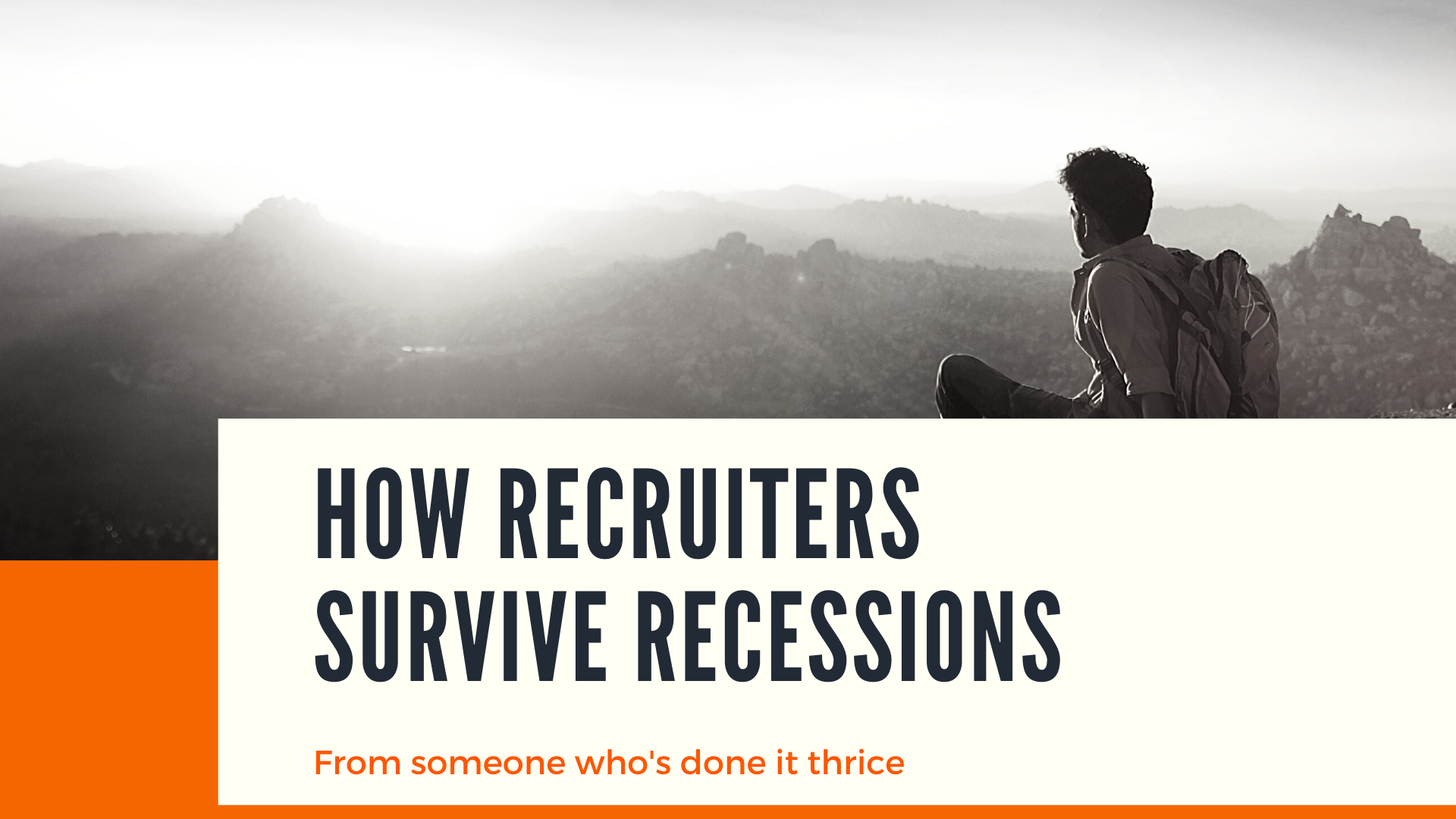
What is Recruitment 4.0?
Let’s be honest, it’s unlikely your recruitment business will ever be the same as it was in February 2020, and that could be a good thing.
I’m going to explain how this new world creates an incredible opportunity for recruitment company owners to re-engineer their business.
But first I need to explore where we find ourselves right now: we’re waiting.
Firstly, we’re all waiting on a vaccine and I’m optimistic that one will happen. Yet I’m also a realist about the timescales, because the fastest vaccine ever created was for mumps and that took 4 years.
Social distancing, and its consequences, could continue for quite a while.
Secondly, we’re waiting on a recession.
Things are dicey now but when furlough ends the real recession starts. There are likely to be swathes of redundancies across the whole economy, not just in recruitment. The planning has already begun.
Most recruitment company owners understand these things but what worries me is how many owners are focused on “just getting through this”. As if it’s going to end sometime soon and we’ll then be in a new normal that’s a lot like the old normal.
But we are living in the new normal!
Waiting for the world to improve is a very risky strategy indeed. The smart money is on making the world work for you as it is.
Anyway, Enough of the bad news! I’m an optimist after all, and there is great news to be had:
this crisis means you can reinvent your business, making changes you’ve been putting off for ages.
The Opportunity
As a business owner, your company should work for you, not the other way around. If that balance is off, then now is a great time to address things, if you’re willing to be bold.
Personally, I think we all need to be bold right now. Those who reengineer their recruitment business into something that’s fit for the new world might just find it was the best thing that could have happened to them.
Easy for me to say, I know. How can you make time to conjure up a new model for your business in amongst all the current noise?
Let me give you a template. Something you can take away and then customise to your specific circumstances. I’ve called it Recruitment 4.0 and we’re going to explore it through the following five prescriptions: –
- Design a business to deliver your endgame
- Be agile
- Revisit what you sell and who you sell it to
- Win new clients and care for established ones at a distance
- Manage outcomes not people
1. Build a business that delivers your endgame
In a 2018 survey completed by Rycroft Glenton they discovered that only 0.2% of recruitment companies end in a trade sale for even a modest sum. I hate being the bearer of bad news, but the chances of selling your business and retiring on the proceeds are very slim indeed.

Recruitment 4.0 avoids that issue
But I do know what it takes to join the 0.2% club.
I’ve built and sold two recruitment businesses, all the way from kitchen table to trade sale and I’ve seen others do it too. All those businesses shared some common characteristics such as:
- EBITDA in excess of £1m, preferably over £2m.
- Contract business with sustained revenue streams. Perm businesses must be quite large to be attractive
- Something extra that attracts a buyer: strong in a geographic area; a real niche that they have cornered in the market or other complimentary service offerings e.g. my last business had a Microsoft Gold Partnership.
- A strong and varied client estate with little dependency on one or two key clients that could disappear and damage revenues.
Rather than gamble on those odds, I encourage my clients to seek a different path: to build a cash-cow business that generates enough money each year for them to withdraw and invest privately.
This way they build their wealth independently of their business over a decade or so. It may not be the most tax efficient way of doing it but it’s by far the safest.
Take this opportunity and re-engineer your business into a cash cow. Get some financial planning done by a professional and be clear how much wealth you need to be financially independent. From this it’s easy to figure out how much your company must make so you can withdraw your annual investment fund. This is all about you!
2. Be agile
In the past decade many recruitment owners have increased their committed spend and swelled their permeant team. Why wouldn’t they? It’s been a great decade and you could be confident the money would come in.
In the new world it would be wise to do the opposite.
You want a business that can flex, allowing you to cut costs when needed by simply terminating a few monthly payments, but also expand quickly if there is a big opportunity.
The three key areas here are your offices, software licenses and staff.
Offices
Managed offices with a months’ notice allowing you to quickly increase or decrease your office space, or even terminate it altogether. They are a little more expensive per month but not as expensive as finding yourself stuck in an under-used office on a five year lease.
Software licences
Often you have an annual and a monthly option, with monthly being a little more expensive over the 12 months. I recommend you take the latter. That big wedge of cash for an annual license could be money you suddenly need to survive.
Besides many recruitment software products were built during the last decade, a candidate driven market. We’re now firmly in a client driven market, so some of them may not function as well as they did.
Staff
We can reduce our staff costs, but the traditional means to do so has some pretty big downsides:
- making people redundant carries a cost with it, usually when you can’t afford it.
- it can sap morale.
- it’s not a very pleasant thing to do.
The alternative is to not take on the staff cost in the first place, and instead build a virtual team.
Tim Ferris wrote an excellent book on this called The Four-Hour Work Week. It’s a little grandiose in its claims, but at its core the message is clear. By outsourcing as much as you can, you get several benefits:
- Flexibility to buy, or not buy, depending on need.
- Easily swap suppliers if you feel the current one isn’t cutting it anymore.
- Often these external experts are more skilled and productive than their permanently employed equivalents.
Although outsourcing may appear to be more expensive, in the end it can work out cheaper and deliver you a better service. I recommend you consider some of the following for outsourcing:
- Back office systems – many accountants will do this for you, for a fixed monthly cost.
- Personal assistants e.g. you can hire competent PAs from the Philippines for about $5 an hour.
- Marketing and communications – engage only when you need them
- I’ve seen some recruiters supplement their research teams with offshore people. They don’t call the candidates, but they do find and qualify them very adequately.
All this might seem alien to you, especially if you formed your business in the last 10 years but in the new world agility could make you more profitable and in extreme cases could be the difference between the life or death of your business.
Minimise committed spend and outsource what you can!
3. Revisit what you sell and who you sell it to
Back to Tim Ferris again. He also discovered that 80% of his profits came from the 20% of his clients. This came as a revelation to him because he realised if he dispensed with the 80% and purposely sought out more clients like the 20% his profits would grow exponentially. He did and they did.
I’ve got first-hand experience of this, in my first business I once stopped trading with one of my biggest clients.
Our turnover with them was in the millions, but the margins and expected service levels meant we didn’t make money. Not long after I stopped trading with them, our turnover dropped, obviously.
But our profits increased. Significantly increased.
I’ll admit, right now is probably not the time to be cutting out clients. But, now is the time to plan:
- carefully define what your 20% clients look like
- plan the departure of the 80% just as soon as you’re able.
Be brave. Plan a different client estate that delivers more profit with less hassle and then go about creating it for yourself. Remember that you have a good deal of control over who you trade with.
When it comes to products, my advice is to focus. Let me tell you a story that illustrates why.
Some years ago, I was working with a recruiter who had as many desks as he had people. Whenever he hired a new salesperson, they bought a corner of the market with them. He let them run with it but if they left, he fought to keep the desk going.
Usually at a much-reduced size, but for more effort.
I can’t recall the exact details now, but I’d say he had a dozen or more desks like this and he wasn’t a large outfit. Those desks were a drag on his business because the key to success in anything is focus, and they took up more of his attention than the returned in profit.
Concentrate to penetrate
Penetrate to dominate
Dominate to accumulate
Remove anything that weakens your focus. Better to be known as the go-to-guy or go-to-gal for a specific service than take the attitude “it’s close to what we do, we can make some money, let’s do it”. In business the word “no” creates more wealth that it loses.
4. Win new clients and care for established ones at a distance.
Before the crisis recruitment tended to rely on three different ways to win new business:
- High value clients that require quite a lot of face-to-face interaction to convert.
- Low value clients, or spot deals, won through cold calls and online activity.
- For high and low value there might be a stream of referrals and introductions.
Here’s the problem, face-to-face is now not an option, referrals tend to reduce significantly during a recession and we’re not going to reach your end goal by chasing spot deals every month.
So, we now need a process that delivers high value clients but that doesn’t rely on face to face interactions or new client referrals.
The good news is that this can be done with relative ease, but it’s too large a subject for me to cover here. However, here are three things for you to consider: –
- Webinars: when used properly they are a powerful way to tick a lot of boxes for your prospects: value focused, knowledgeable, likeable etc. However, just running them is nowhere near enough. To understand more, watch our recorded webinar that explains how to use webinars to win new clients.
- Focused New Business: 360 recruiters always carried a lot of risks with them but in this distanced world they are even less desirable. A jack of all trades is a master of none after all. So, there is a need for a focused, measured and fully equipped new client acquisition function.
- Communication: Sharpening up your key messages, and how you deliver them, is vital. Prospects will research you online before they engage. This includes social media, your website, blogs, emails etc and the formats including audio, video and graphic. I can’t stress this one enough.
Client Care
The secret to exponential growth is never lose a client you don’t want to. That was a key reason my first business grew from zero to £40m in a decade, and it can drive your growth too.
Put as much effort into established clients, as you do new clients.
- Give each of them a contact regime.
- Create clear line of two-way communication. Something that works without ever meeting them.
- Deliver value to them by the bucket
Clients will be more susceptible during the turbulent times ahead. Tempting, cheaper deals offered by competitors will catch their eye more than they did in the good times. So you must measure and monitor your activity with them very closely. I recommend you instigate a VotC (Voice of the Customer) process as soon as possible.
Design processes that assume no face to face contact and use every one of the latest tools to help you identify prime prospects, start a conversation, convert them to clients and then care for them.
5. Manage outcomes not people
Recruitment businesses, like many professional services companies, are built on proximity management.
Proximity Management: managers know what’s going on because they sit near their team and can see what they are doing.
Well that all changed on March 23rd, 2020 when we entered lockdown, and it will never be quite the same again. Here’s why.
Firstly, social distancing is here to stay for the foreseeable future. We know because our recent podcast with Stephanie Lunn, Group HRD for Guinness world records, revealed what they had been forced to do in their Beijing offices.
- In the office just one day a week,
- Pre booked hot-desking,
- Wearing a mask all day,
- Continual cleaning the office spaces all day
and we’ll probably have to do more here: regular health and safety risk assessments, the canteen and kitchen become places of danger and don’t even start me on the funky breakout room.
Added to all that, many people don’t want to go back to a 5-day a week office existence and can now prove they don’t have to.
We ran a twitter poll that had 93 respondents. In it we discovered that: –
- 61% of respondents only wanted to be in the office 2 or 3 days a week.
- 27% wanted to work in the office 1 day a week.
- 10% said they’d prefer to work in the office 4 days a week
- 2% opted to return to working in the office 5 days a week.
If we accept that homeworking is here to stay for the foreseeable future how does that affect how people are managed?
Well, obviously proximity management has gone the way of T-Rex, but you still need to manage your people, so what will this new style of management look like?
The Alternative
It’s called Outcome management and to make it work you need accurate data, an emotional contract and trust.
For the trust and emotional contract elements I recommend you listen to our podcast with leading leadership coach Alan Kenny.
Data is a little easier: Define the outcomes you want in 4 different datasets: –
- GP/Revenue you expect per month
- Forecast for the next three months so the manager can have confidence this will continue.
- 18-month pipeline to show that this will continue in the longer term.
- Quality of service feedback from the clients to prove that they’re being looked after properly – VotC again!
With this data you could manage your people from a beach in Acapulco.
Sure, it would take some time to setup but what alternative do you have? Well you could pursue activity-based management. In this you manage people based upon their activity data such as CVs sent, phone calls made, sales pitches, offers and so on.
Now this is useful diagnostic data if somebody begins to underperform but it does not create outcome management.
We recommend that people begin with activity-based management with the promise that as soon as they can prove they are delivering on all four of the Outcome based metrics they can swap over. Some will never make the jump, but many will and that will boost growth considerably.
You’ll also have to adjust the way you communicate with your people; help them to socialise with their colleagues and even how you onboard new starters and run appraisals.
One last thing; many recruitment team-leaders are also fee-earners often with quite stiff targets. Moving forward you may need to reconsider that. Outcome management, as well as the softer aspects of distance management, take time and a new set of skills.
If somebody manages others you may consider: –
- allowing more time in their working week for them to manage their people and
- investing in some management training for them.
In the new world they’re going to need it. So, my advice is to recognise that the new world will involve more home working than office working. This in turn, will require more robust management information and better trained managers to use it.
Outcome management is more effective than activity management, but I accept that not everybody can make that leap. However, the rewards are enormous for those who can.
Summary
This may all seem a lot to take in, but I’ve only included things I thought were worth considering.
Just imagine, for a second what it would be like to run a Recruitment 4.0 business.
- Every day you know you’re taking a step closer to your endgame.
- You weather any storm without taking a step back, and every opportunity is pounced on.
- You work with the clients you choose, who buy into you, your business and what you stand for
- Your core team are winning new business and dazzling clients, no matter where they work.
- You know exactly what is going on right now and can reliably predict the next 18 months. From anywhere you choose to base yourself.
The new world is here now! My advice is to build something that works in the current market and will deliver what you need to become financially independent.
All whilst still having a good lifestyle and earning what you need.
Remember, as the owner your needs take priority; the business works for you, not the other way around!
Make the changes necessary to achieve this and you may well look back on these times as the defining period in your business career.









Leave A Comment
You must be logged in to post a comment.